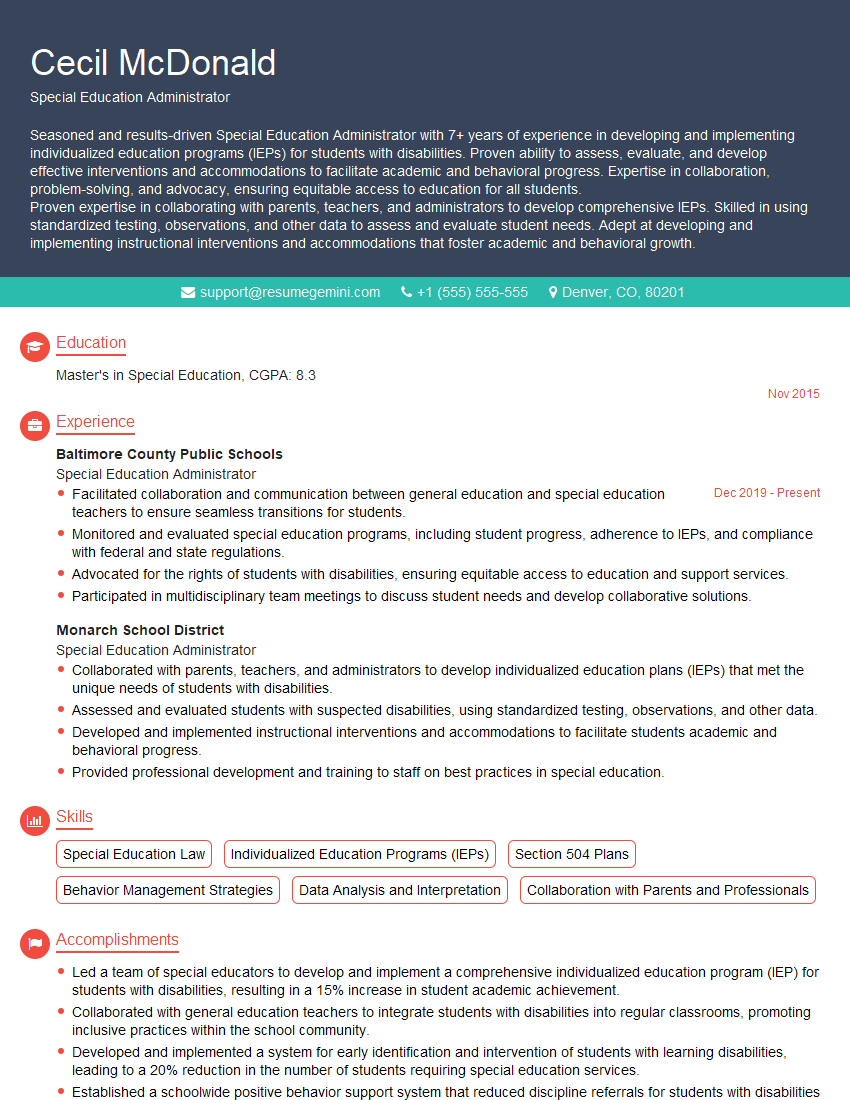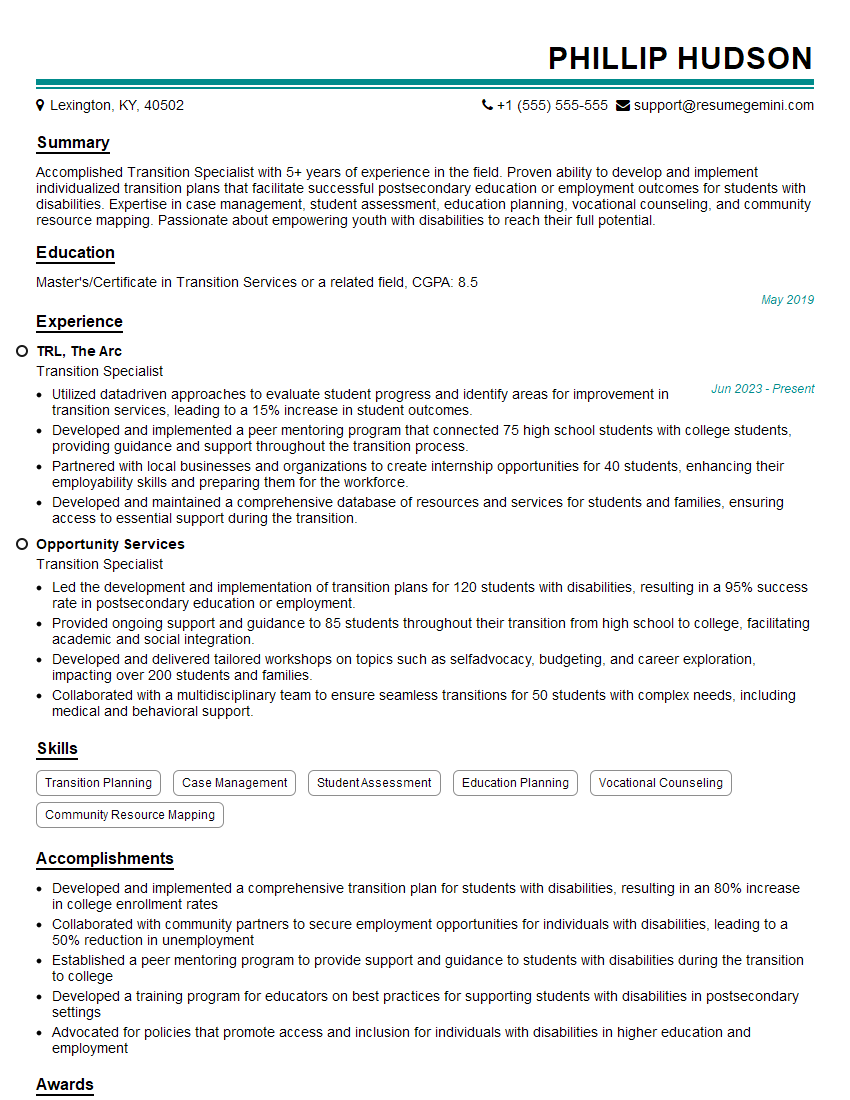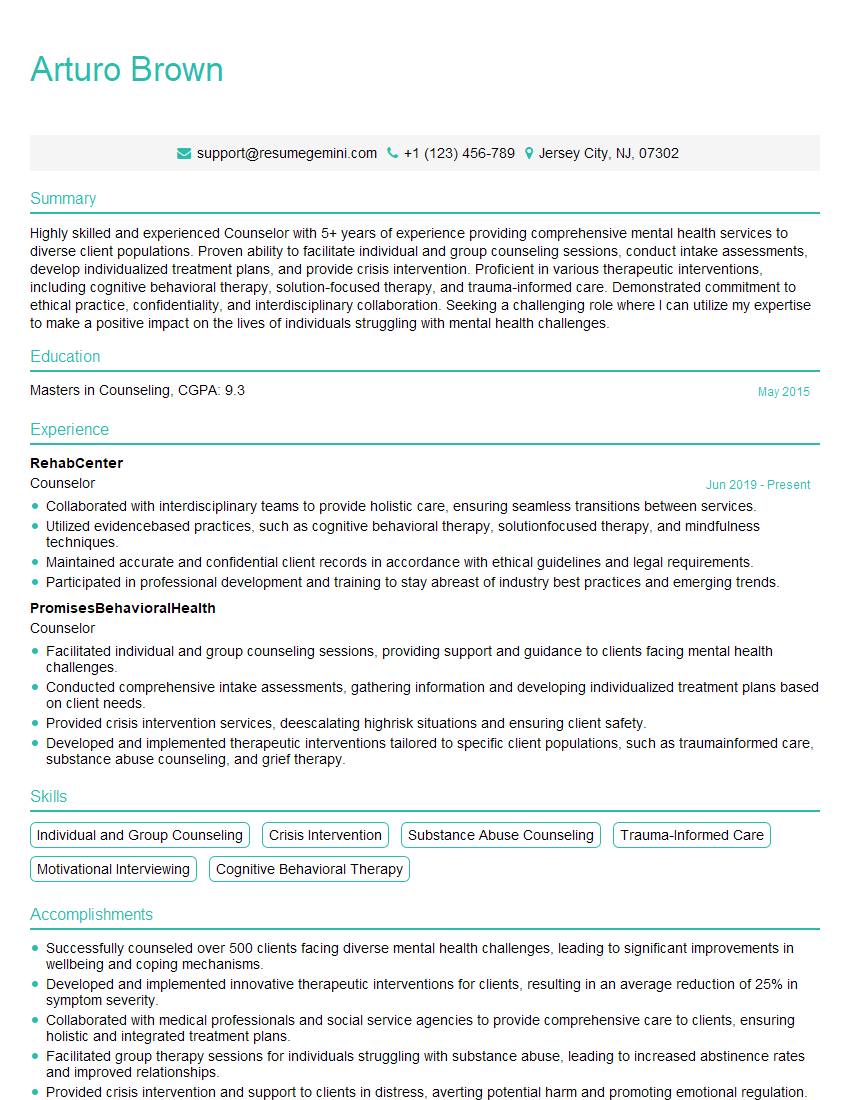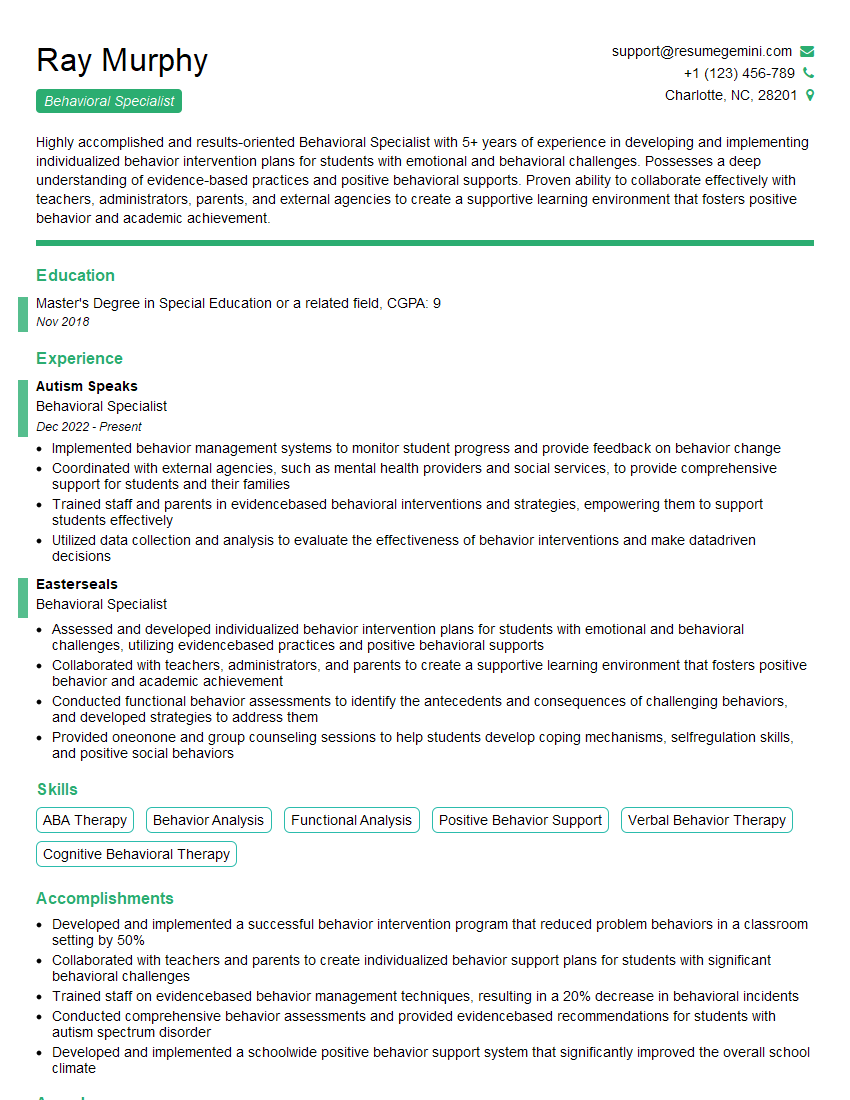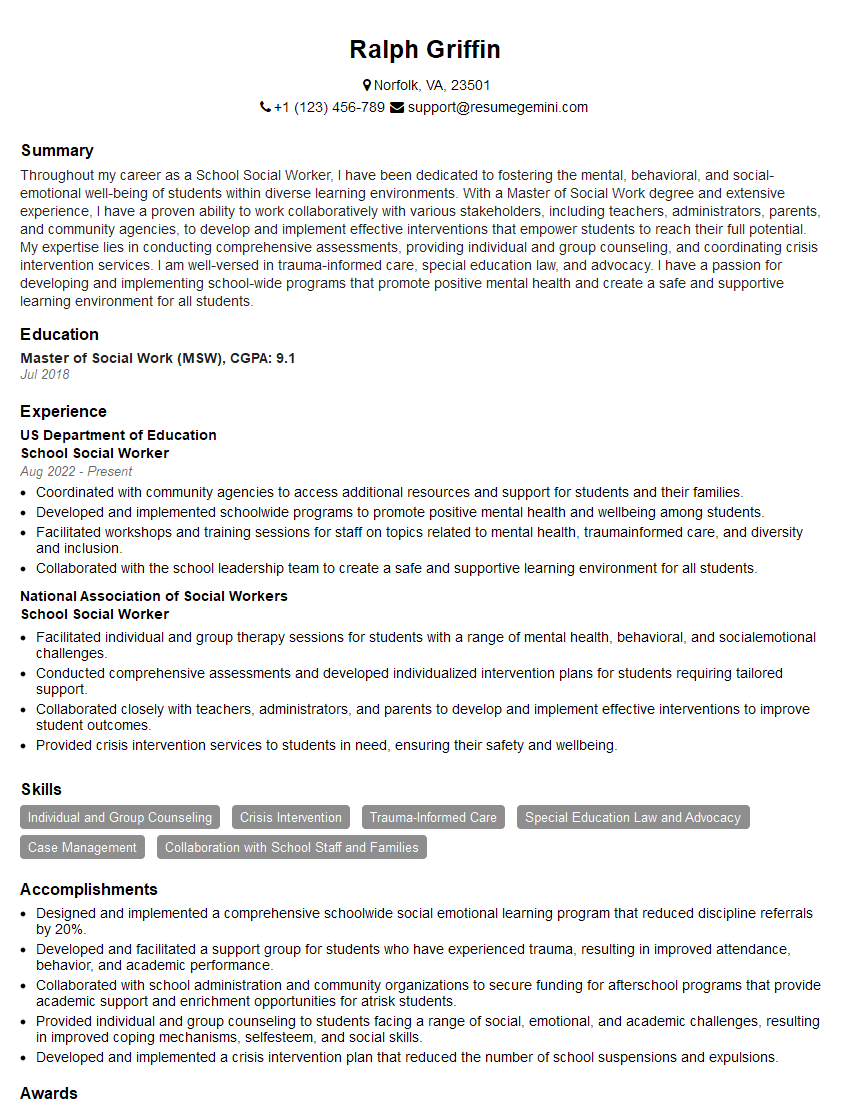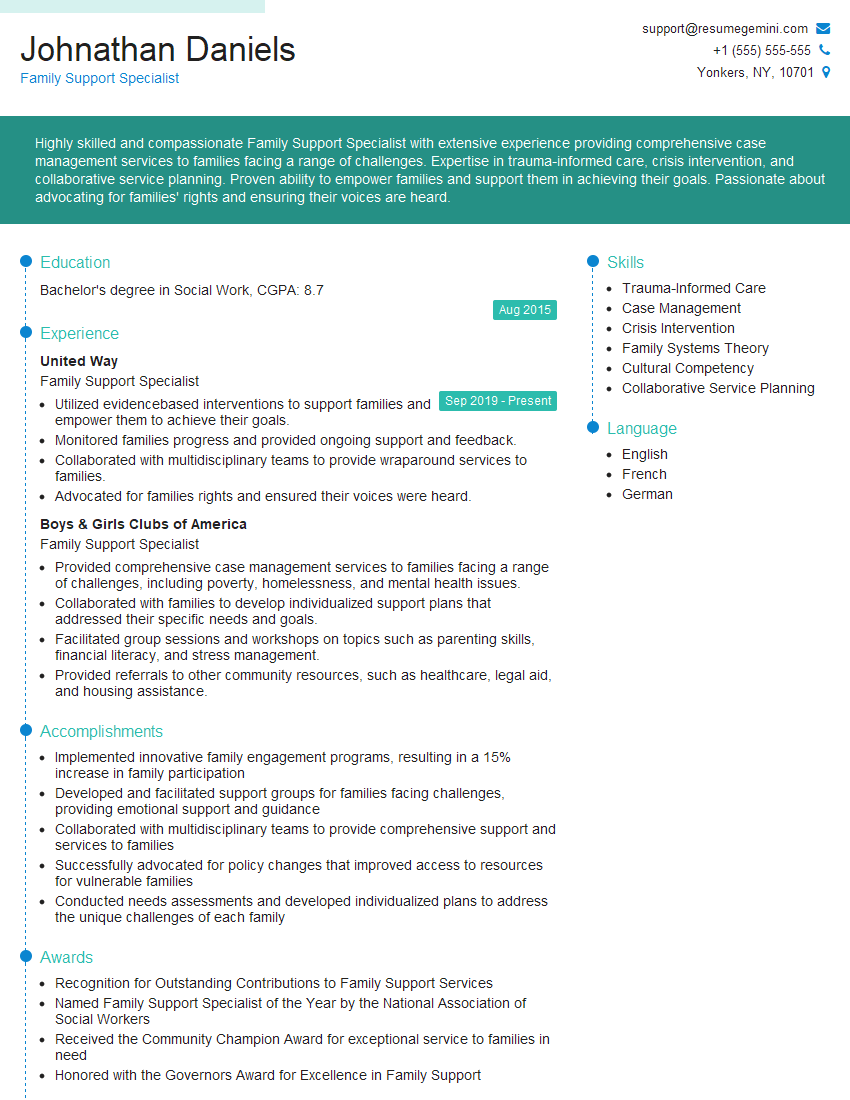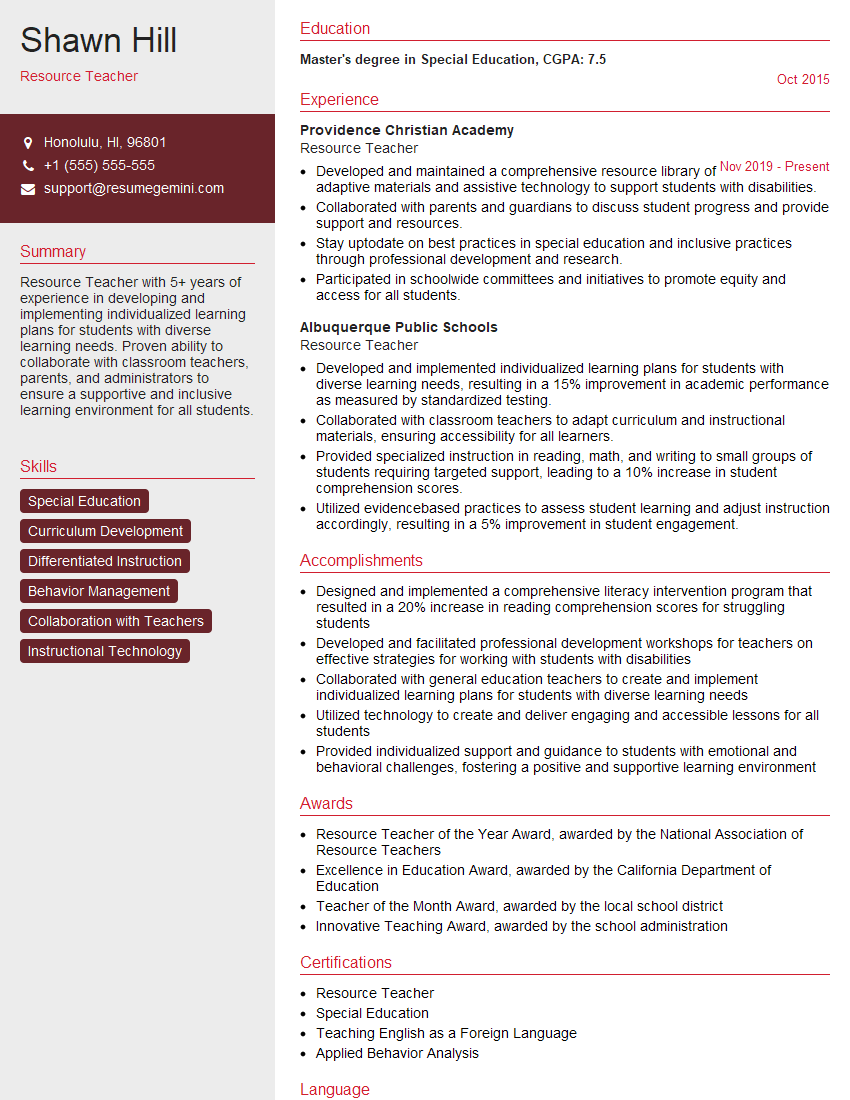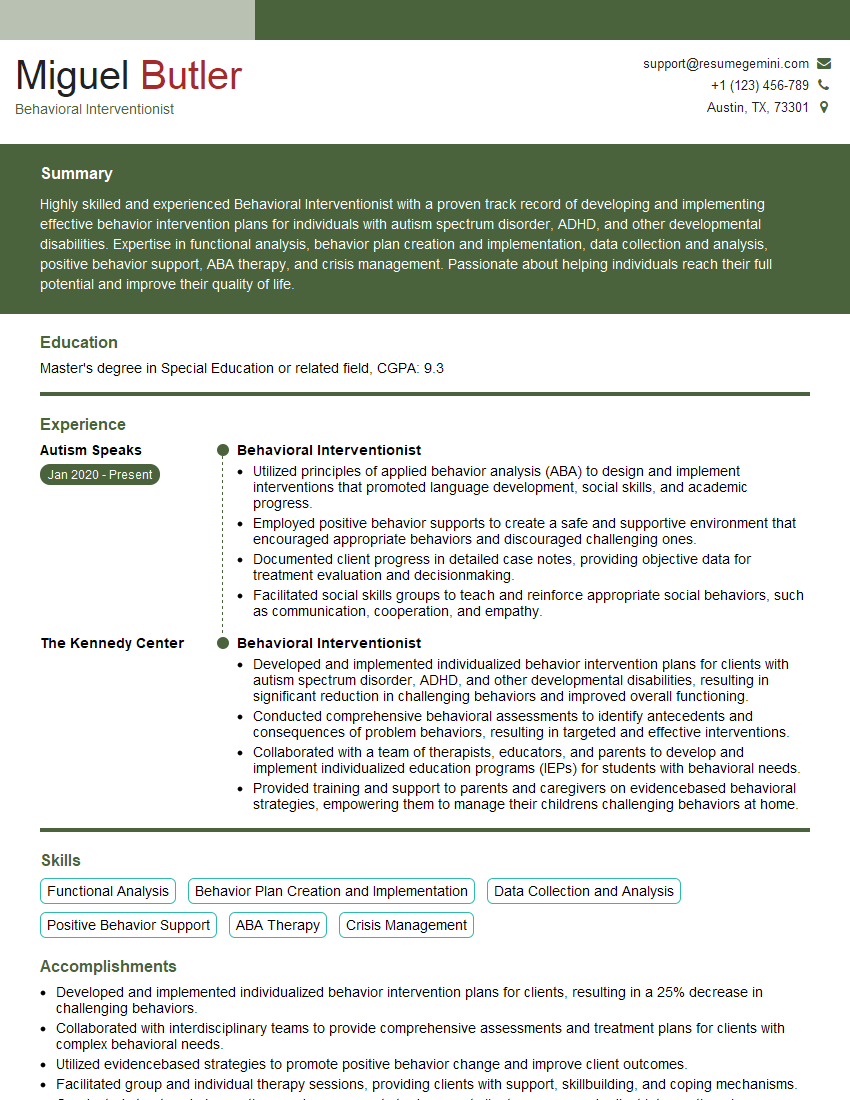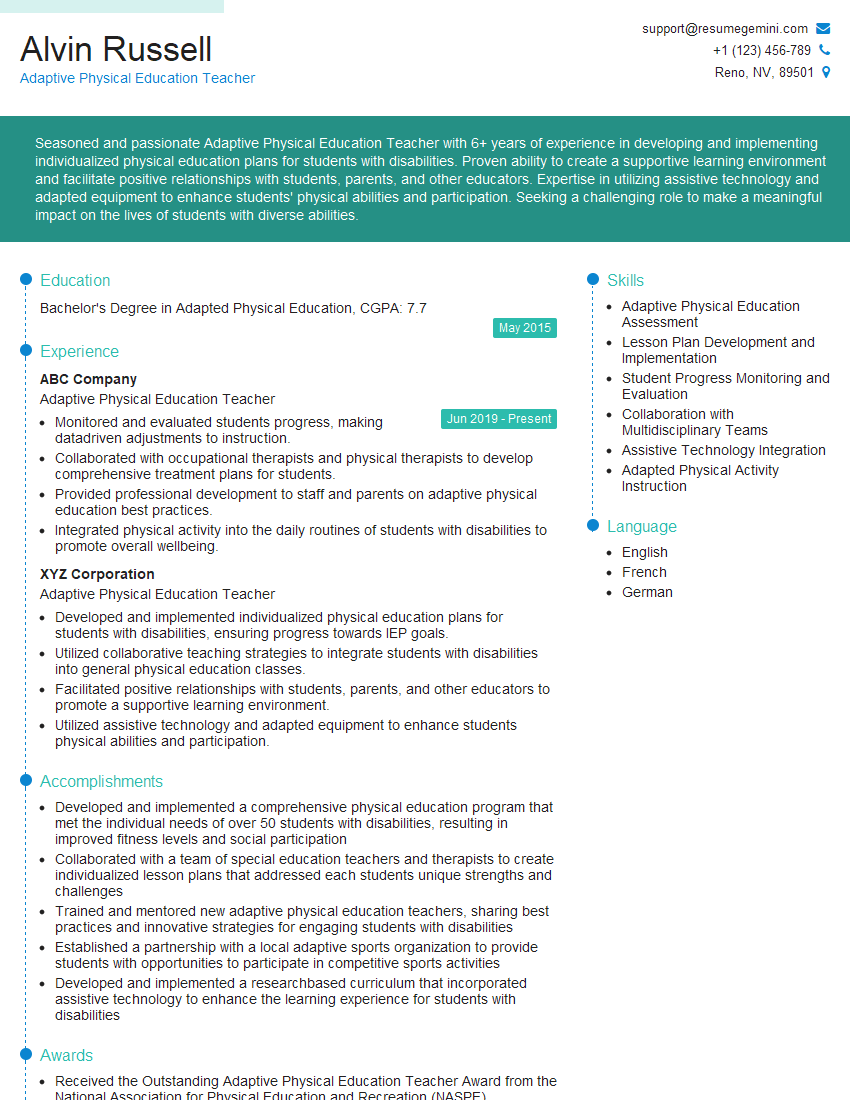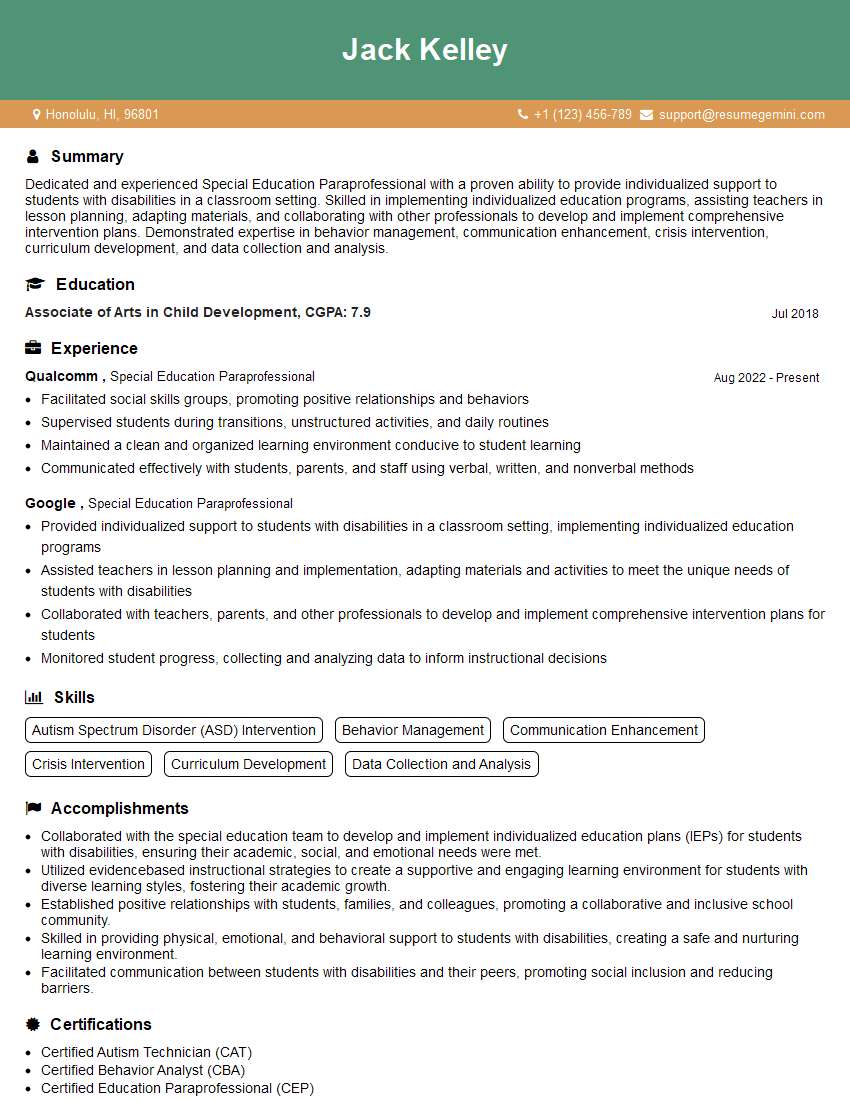The thought of an interview can be nerve-wracking, but the right preparation can make all the difference. Explore this comprehensive guide to Family-Centered Practices for Students with Mental Handicaps interview questions and gain the confidence you need to showcase your abilities and secure the role.
Questions Asked in Family-Centered Practices for Students with Mental Handicaps Interview
Q 1. Describe your understanding of Family-Centered Practices in special education.
Family-Centered Practices (FCP) in special education recognize the family as the constant in a child’s life and the expert on their child’s needs, strengths, and preferences. It’s a philosophy that shifts the focus from solely providing services *to* the student to collaborating *with* the family to create a supportive and effective educational plan. Instead of professionals making decisions *for* the family, FCP emphasizes shared decision-making, mutual respect, and a genuine partnership. This collaborative approach aims to empower families, increase their confidence, and ensure that the student’s education reflects their unique needs and family values.
In practice, FCP means actively involving families in all aspects of the educational process, from assessment and goal setting to intervention and evaluation. This includes respecting family preferences, acknowledging cultural differences, and providing resources and support to strengthen family capabilities.
Q 2. How do you incorporate family perspectives into Individualized Education Programs (IEPs)?
Family perspectives are crucial to developing effective IEPs. I begin by inviting families to participate in every IEP meeting, ensuring they have ample opportunity to share their child’s strengths, challenges, and unique learning styles. I use open-ended questions, such as “What are your hopes and dreams for your child’s education?” and “What strategies have you found helpful at home?” to elicit their valuable insights. I carefully document their input, ensuring their perspectives are reflected in the goals, services, and accommodations outlined in the IEP. I also ensure that I explain the educational jargon in plain language and involve them in setting realistic and attainable goals.
For example, a family might share that their child thrives in hands-on activities. This insight informs the IEP’s goals and might lead to incorporating more project-based learning and kinesthetic approaches. Conversely, if the family mentions their child struggles with transitions, the IEP might include strategies to support smoother transitions both within and between school activities.
Q 3. Explain the importance of communication with families in supporting students with mental handicaps.
Open and frequent communication is the cornerstone of successful support for students with mental handicaps. Families are the primary caregivers and possess invaluable knowledge about their child’s behaviors, triggers, and responses. Regular communication ensures that school and home strategies align, creating consistency and reducing confusion for the student. Effective communication minimizes misunderstandings and allows for timely adjustments to support plans. When families feel heard and informed, they are more likely to actively participate in their child’s education and advocate for their needs.
Imagine a student experiencing anxiety. Regular communication between the school and family allows for the sharing of strategies – calming techniques used at school can be reinforced at home, providing consistent support and reducing the child’s overall stress.
Q 4. What strategies do you employ to build trust and collaboration with families?
Building trust and collaboration involves actively listening to families, validating their concerns, and demonstrating respect for their expertise. I start by creating a safe and welcoming environment where families feel comfortable expressing their thoughts and feelings. I practice active listening, regularly summarizing what I’ve heard to ensure understanding. I demonstrate transparency by sharing information openly and honestly, even if it involves challenges. I actively seek their input, involve them in decision-making, and celebrate their contributions. Offering choices whenever possible, shows that I value their input and empowers them in the process. Regular check-ins, beyond formal IEP meetings, further solidify the relationship and demonstrate ongoing commitment.
For example, consistently following through on commitments, such as returning phone calls promptly and providing timely updates, builds trust. Celebrating successes, both big and small, strengthens the collaborative spirit.
Q 5. How do you adapt your communication style to meet the diverse needs of families?
Families have diverse communication styles, backgrounds, and levels of understanding of special education. Adapting my communication style is paramount. I always begin by assessing the family’s preferred communication methods – phone calls, emails, text messages, or in-person meetings. I use clear, concise language, avoiding jargon, and ensure that all written communications are accessible. If needed, I provide translations or utilize visual aids to enhance understanding. I actively adjust my communication style based on the family’s cultural background and communication preferences, showing respect for their unique perspectives. Offering various communication options empowers families to choose the method that best suits their needs and comfort level.
For example, a family whose primary language is not English may benefit from having a translator present at meetings. A family that prefers concise, written updates might be better served by email rather than lengthy phone conversations.
Q 6. Describe a time you had a conflict with a family. How did you resolve it?
I once had a conflict with a family regarding a proposed behavioral intervention plan. The parents felt the plan was overly restrictive and didn’t adequately address the underlying causes of their child’s challenging behaviors. I actively listened to their concerns, validating their feelings and acknowledging their expertise about their child. I then explained the rationale behind the proposed plan, using data and observations to support my recommendations. We engaged in collaborative problem-solving, exploring alternative strategies and modifying the plan to better align with the family’s preferences and concerns. This included incorporating some of their suggestions for home-based interventions and adjusting the plan’s implementation based on our shared understanding.
The key to resolving the conflict was open dialogue, mutual respect, and a shared commitment to the child’s well-being. The revised plan resulted in a more collaborative and effective approach, which benefited both the student and the family.
Q 7. How do you involve families in the development of behavioral intervention plans?
Families are integral to developing effective behavioral intervention plans (BIPs). I involve them from the initial assessment phase, gathering information about the student’s behaviors in different settings, including home. I collaborate with families to identify triggers, antecedents, and consequences of challenging behaviors. Together, we brainstorm positive strategies and interventions, ensuring the plan is both realistic and manageable for the family to implement at home. I provide families with training and support on implementing the strategies and encourage them to actively participate in monitoring the plan’s effectiveness. Regular communication and feedback loops ensure that the plan remains aligned with the student’s needs and family preferences.
For example, if a student exhibits challenging behaviors during homework time, the family might suggest strategies they’ve tried at home. These could include incorporating breaks, creating a quieter work space, or using a reward system. By including these home-based strategies in the BIP, we ensure consistency and maximize the likelihood of success.
Q 8. What are some common challenges families of students with mental handicaps face, and how can educators support them?
Families of students with mental handicaps often face a unique set of challenges. These can include navigating the complex special education system, accessing appropriate therapies and services, managing the emotional and financial burdens of caring for a child with special needs, and dealing with the social stigma that can sometimes accompany a diagnosis. Sibling relationships can also be affected. They may also experience increased stress and anxiety levels.
Educators can provide crucial support by acting as a liaison between the family and the school, providing clear and consistent communication regarding the student’s progress and needs. This includes regularly scheduled meetings, providing accessible progress reports written in plain language, and actively listening to the family’s concerns and perspectives. Educators can also help families access community resources, advocate for their child’s needs within the school and district, and offer workshops or training on relevant topics such as behavior management techniques or strategies for promoting independence.
For example, I once worked with a family whose child was struggling with significant behavioral challenges. By collaborating closely with the parents, we developed a behavior intervention plan (BIP) that was implemented consistently at both home and school. This collaborative approach led to a significant reduction in challenging behaviors and improved the child’s overall well-being. We also connected them with a local support group for families of children with similar diagnoses, fostering a sense of community and shared experience.
Q 9. How do you ensure cultural sensitivity and inclusivity in your interactions with families?
Cultural sensitivity and inclusivity are paramount in working with families. It’s crucial to understand that families come from diverse backgrounds, with varying beliefs, values, and communication styles. I begin by actively listening to understand the family’s unique cultural context and perspectives. This involves asking open-ended questions, paying attention to nonverbal cues, and being mindful of potential language barriers.
I ensure that all communication materials are accessible and translated if necessary. I also make an effort to learn about the family’s cultural practices and traditions and incorporate these into my interactions whenever appropriate. For instance, I might learn about the family’s preferred communication styles or adjust meeting times to accommodate religious observances. Collaboration is key – I involve families in decision-making processes relating to their child’s education, respecting their expertise in their child’s life.
For example, when working with a family from a collectivist culture, I adapted my approach to include more extended family members in meetings and decision-making processes. Understanding this cultural nuance allowed for a more effective and respectful partnership.
Q 10. What resources do you know of that can support families of students with mental handicaps?
Many resources exist to support families of students with mental handicaps. These include governmental agencies such as the local education agency (LEA) and the state department of education, which often provide information on special education rights, services, and financial assistance. Non-profit organizations dedicated to specific disabilities or mental health conditions offer crucial support, often providing counseling, support groups, and educational resources. Parent advocacy groups can connect families with valuable resources and guidance and provide a strong network for shared experiences and support.
Furthermore, online resources such as websites and support forums offer information, tips, and a platform for connecting with other families facing similar challenges. Local hospitals and community health centers often have dedicated departments for children’s mental health that can provide therapy and resources. Finally, libraries often have extensive collections of books and materials on specific disabilities and coping mechanisms.
It’s essential to connect families with the most appropriate resources based on their specific needs and circumstances. A tailored approach ensures families get the specific support they need, when they need it.
Q 11. Explain the role of assistive technology in supporting students and involving families.
Assistive technology (AT) plays a vital role in supporting students with mental handicaps and fostering family involvement. AT encompasses a wide range of tools and devices designed to enhance learning, communication, and independence. This can include communication aids (e.g., augmentative and alternative communication devices), adaptive learning software, sensory tools, and mobility aids.
The involvement of families in selecting and implementing AT is crucial. Families are experts on their child’s needs and preferences, and their input ensures that the chosen technology effectively meets the child’s unique requirements and integrates seamlessly into their daily life. Training for both the student and family on using the technology is essential for successful implementation. This collaborative approach not only empowers families but also fosters a sense of ownership and shared responsibility in the child’s educational journey.
For instance, a student with autism might benefit from a visual schedule created using an app, allowing for increased predictability and reduced anxiety. Involving the family in designing this visual schedule ensures that it aligns with the student’s routines at home and school. We might also explore using assistive communication apps so they can communicate their needs more effectively.
Q 12. How do you utilize data to inform family partnerships and student progress?
Data plays a crucial role in informing family partnerships and monitoring student progress. This data might include academic performance, behavioral observations, participation in therapy, and feedback from both the student and family. Data collection methods should be diverse, combining formal assessments with informal observations and family interviews.
Data should be presented clearly and accessibly to families, using plain language and visual representations such as graphs and charts. Regular meetings provide opportunities to discuss the data, collaboratively interpreting the findings, and adjusting interventions as needed. Open communication ensures that families understand the data and feel empowered to participate in making data-driven decisions regarding their child’s educational program.
For example, tracking a student’s progress in social skills might involve charting the frequency and quality of positive social interactions. Sharing this data with the family allows us to collaborate on strategies to further enhance the student’s social skills, such as practicing social scenarios at home or incorporating social skills training into the school curriculum.
Q 13. Describe your experience with parent training or workshops related to special education.
I have extensive experience designing and conducting parent training workshops and individual sessions on various aspects of special education. These workshops often focus on practical strategies for supporting students’ academic, social-emotional, and behavioral development. Topics include behavior management techniques, communication strategies, and effective ways to advocate for their child’s needs within the educational system.
The workshops are typically interactive, employing a combination of lectures, demonstrations, role-playing, and group discussions. I often incorporate real-world examples and case studies to make the information relatable and applicable to the participants’ unique situations. Individual sessions provide more personalized support and allow for a deeper exploration of specific concerns and challenges. I tailor my approach to the families’ learning styles and preferences, ensuring they feel comfortable and supported throughout the process.
For example, I recently developed a workshop on using visual supports to manage transitions for students with autism spectrum disorder. The workshop included practical examples, hands-on activities, and opportunities for families to share their experiences and learn from one another. The feedback from the families was overwhelmingly positive, with many reporting that the strategies they learned made a tangible difference in their child’s daily life.
Q 14. How do you measure the effectiveness of your family-centered practices?
Measuring the effectiveness of family-centered practices requires a multifaceted approach that incorporates both quantitative and qualitative data. Quantitative data might include standardized test scores, attendance rates, behavioral data, and family satisfaction surveys. Qualitative data is equally important, including feedback gathered through interviews, focus groups, observations of family-school interactions, and case studies.
Analyzing this combined data allows for a comprehensive assessment of the impact of the family-centered practices. For example, a significant increase in student engagement, improvement in academic performance, and positive feedback from both the student and family on their experience would all indicate the effectiveness of the implemented practices. Regular evaluation and feedback loops are crucial to make necessary adjustments and ensure that the practices remain responsive to the ever-evolving needs of the students and families.
Furthermore, tracking the family’s ability to advocate for their child and their increased confidence in navigating the special education system are key indicators of successful family-centered practices. By continuously monitoring and evaluating our interventions, we ensure that we are providing the most effective and supportive environment possible for our students and their families.
Q 15. What are some ethical considerations in working with families of students with mental handicaps?
Ethical considerations in working with families of students with mental handicaps are paramount. We must prioritize respect, autonomy, beneficence, and non-maleficence. Respect means valuing their perspectives and experiences, even if they differ from ours. Autonomy involves ensuring families have the right to make informed decisions about their child’s education and care. Beneficence requires us to act in the best interests of the student and family, always striving to promote their well-being. Non-maleficence means avoiding actions that could cause harm.
- Informed Consent: Obtaining truly informed consent is crucial. This means ensuring families understand all aspects of interventions, potential benefits and risks, and alternative approaches, in language they can easily comprehend. We need to be mindful of cultural factors and potential language barriers.
- Avoiding Stereotypes and Biases: We must actively combat our own biases and assumptions about families and their capabilities. Every family is unique, and their experiences should inform our approach, not preconceived notions about disability.
- Confidentiality: Protecting the family’s privacy and the student’s personal information is essential, as discussed further in a later question.
- Cultural Sensitivity: Recognizing and respecting cultural differences in family structures, communication styles, and decision-making processes is absolutely vital. We need to be sensitive to varying beliefs and practices.
For example, I once worked with a family who initially resisted certain therapies due to their cultural beliefs. By engaging in respectful dialogue and understanding their perspective, we collaboratively found an approach that aligned with their values while still addressing the student’s needs.
Career Expert Tips:
- Ace those interviews! Prepare effectively by reviewing the Top 50 Most Common Interview Questions on ResumeGemini.
- Navigate your job search with confidence! Explore a wide range of Career Tips on ResumeGemini. Learn about common challenges and recommendations to overcome them.
- Craft the perfect resume! Master the Art of Resume Writing with ResumeGemini’s guide. Showcase your unique qualifications and achievements effectively.
- Don’t miss out on holiday savings! Build your dream resume with ResumeGemini’s ATS optimized templates.
Q 16. How do you handle situations where families disagree with your professional recommendations?
Disagreements with families are inevitable. The key is collaborative problem-solving, focusing on shared goals for the student. I approach such situations with empathy and respect.
- Active Listening: I start by actively listening to the family’s concerns and perspectives without interruption. I try to understand their rationale and address their worries empathetically.
- Shared Goal Setting: I work with the family to define shared goals for the student. This shared understanding often helps to bridge disagreements.
- Providing Information: I provide clear, concise information about the rationale behind my recommendations, using non-technical language and visual aids if necessary. I explain the evidence-based practices that underpin my suggestions.
- Compromise and Collaboration: I am willing to compromise and find alternative approaches that satisfy both the family’s and my professional concerns, always keeping the student’s best interests at heart.
- Seeking Support: If disagreements persist, I seek guidance from colleagues, supervisors, or other professionals with expertise in mediation or conflict resolution.
For example, a family might disagree with an intensive therapy recommendation due to time constraints or financial limitations. We might then explore less intensive interventions or look for community resources to support the family.
Q 17. Explain the importance of confidentiality in working with families.
Confidentiality is crucial for building trust and ensuring open communication with families. It’s legally mandated by FERPA (Family Educational Rights and Privacy Act). We should only share information with others involved in the student’s education or care with explicit parental consent.
- FERPA Compliance: We must strictly adhere to FERPA guidelines, ensuring that we don’t disclose protected student information without proper authorization.
- Secure Record Keeping: We need to maintain secure, confidential records, both physical and digital, using appropriate access controls and encryption.
- Informed Consent for Disclosure: Before sharing any information with other professionals, I always obtain informed consent from the parents or guardians. This includes explaining who will receive the information, how it will be used, and the potential implications.
- Professional Boundaries: Maintaining professional boundaries is important. This means not sharing information casually or with individuals who are not directly involved in the student’s care.
Imagine the damage to a family’s trust if we accidentally disclosed sensitive medical information to an unrelated party. Confidentiality protects the family’s autonomy and allows for open and honest communication.
Q 18. How do you support families during transitions (e.g., between school levels)?
Transitions, like moving from elementary to middle school or high school to post-secondary education, can be particularly stressful for students with mental handicaps and their families. Early and proactive support is essential.
- Early Planning and Communication: I initiate discussions about upcoming transitions well in advance, working collaboratively with the family to create a smooth transition plan. This might involve meetings with staff from both the current and future schools.
- Familiarization Visits: I arrange visits to the new school to help the student and family become familiar with the environment, staff, and routines.
- Individualized Transition Plan (ITP): Working with the family, we develop an ITP that outlines specific goals and strategies for a successful transition. This includes addressing academic, social, and emotional needs.
- Parent Training and Support: I provide the family with training and resources to help them navigate the challenges of the transition. This could include information on specific strategies or connections to support groups.
- Communication and Collaboration: I maintain open communication with the family and the new school throughout the transition process, ensuring a coordinated and supportive environment for the student.
For instance, when a student transitioned to high school, we arranged shadowing days and a pre-transition meeting with the new teachers and support staff. This helped reduce anxiety and promoted a positive experience.
Q 19. How do you involve families in the student’s post-school planning?
Involving families in post-school planning is critical for a successful transition to adulthood. This should begin years in advance of graduation, ensuring families are active participants in shaping their child’s future.
- Individualized Education Program (IEP) Goals: We incorporate post-school goals into the student’s IEP, addressing employment, independent living, and community participation. This provides a structured framework for planning.
- Exploration of Options: We explore various post-school options with the family, including vocational training, supported employment, college, and community-based programs. This could involve career counseling or visits to potential workplaces.
- Skill Development: We work collaboratively with the family and relevant agencies to develop the skills the student needs for successful post-school life, focusing on areas like independent living, communication, and social skills.
- Advocacy and Resource Identification: I advocate for the student’s needs within the school and community, identifying and connecting the family with relevant resources and support services. This could involve working with vocational rehabilitation services, social workers, or community organizations.
- Ongoing Support: I maintain contact with the family and relevant agencies following the student’s graduation, providing support and guidance as needed.
For example, we might help a family connect with a supported employment program, ensuring a job coach is available to assist the student in their new workplace.
Q 20. Describe your familiarity with relevant legislation (e.g., IDEA, FERPA).
I am very familiar with relevant legislation impacting students with disabilities and their families, most notably the Individuals with Disabilities Education Act (IDEA) and the Family Educational Rights and Privacy Act (FERPA).
- IDEA (Individuals with Disabilities Education Act): This federal law guarantees free and appropriate public education (FAPE) to all eligible children with disabilities. It mandates individualized education programs (IEPs) that are developed collaboratively with families and specify appropriate services and accommodations. I understand the requirements for IEP development, implementation, and evaluation, including the process for dispute resolution.
- FERPA (Family Educational Rights and Privacy Act): This federal law protects the privacy of student education records. I understand the regulations regarding the release of information, parental rights to access records, and the implications for confidentiality in my work with families.
My understanding of these laws ensures I act ethically and legally in my interactions with families and in the development and implementation of each student’s IEP.
Q 21. How do you advocate for the needs of students and their families within the school system?
Advocating for students and their families involves actively working to ensure their needs are met within the school system and broader community. This includes navigating bureaucracy, obtaining needed resources, and ensuring equitable access to educational opportunities.
- Collaboration and Communication: I maintain open communication with families, teachers, administrators, and other support staff, fostering a collaborative environment where everyone works towards the student’s success.
- Problem-Solving: I proactively identify and address potential barriers to the student’s learning and development, working to find effective solutions and appropriate supports.
- IEP Meetings and Advocacy: I actively participate in IEP meetings, advocating for the student’s needs and ensuring the IEP reflects their unique requirements. This includes negotiating for appropriate accommodations and services.
- Resource Acquisition: I actively seek out and secure appropriate resources for the student and family, including financial assistance, community services, and therapeutic interventions.
- Systemic Advocacy: I advocate for systemic changes within the school system that promote greater inclusion and equity for students with disabilities. This may involve participating in policy discussions or working with advocacy groups.
For example, I once successfully advocated for a student to receive specialized transportation services, ensuring their safe and timely arrival to school, which was crucial for their success.
Q 22. How would you address a family’s concerns regarding their child’s inclusion in general education?
Addressing a family’s concerns about their child’s inclusion in general education requires a collaborative and empathetic approach. It’s crucial to understand their anxieties and address them directly, while simultaneously highlighting the benefits of inclusion. We begin by actively listening to their specific worries – are they concerned about their child’s academic success, social integration, or the support systems available? Once we understand their perspective, we can tailor our response. For example, if they worry about their child falling behind academically, we can demonstrate how individualized education programs (IEPs) or 504 plans will provide tailored support. We might share success stories of other students with similar needs thriving in inclusive settings, showcasing the positive social and emotional development that can occur. We would also offer opportunities to observe inclusive classrooms and meet with teachers and support staff to alleviate any anxieties related to the practicalities of inclusion. Regular check-ins and open communication remain vital, ensuring we adapt to the family’s needs and address any emerging concerns proactively.
For instance, I once worked with a family who was hesitant about their autistic child’s inclusion in a general education setting due to concerns about bullying and social isolation. We addressed these anxieties by demonstrating the school’s anti-bullying policies, highlighting the social skills training incorporated into the IEP, and arranging for the child to have a peer buddy to ease the transition. We also invited the family to participate in school events and activities to build a sense of community and belonging. Their participation helped them see their child actively engaging socially and developing positive relationships within the inclusive environment, thereby easing their initial fears. Open communication, transparency, and showcasing positive outcomes are key to successfully addressing family concerns regarding inclusion.
Q 23. Explain your understanding of different family structures and dynamics.
Understanding diverse family structures and dynamics is fundamental to effective family-centered practices. We encounter single-parent families, blended families, extended families, same-sex parent families, and families with varying levels of support systems. Each family operates with its unique communication styles, decision-making processes, and power dynamics. Some families may be highly involved in their child’s education, while others may face barriers such as language differences, transportation challenges, or other competing priorities. It’s vital to avoid generalizations and approach each family with sensitivity and respect, recognizing their unique strengths and challenges. For instance, understanding that a single parent might have limited time available for school meetings requires flexible scheduling and proactive communication. Similarly, working with a multi-generational family might necessitate involving multiple family members in discussions to gather diverse perspectives and ensure collective agreement regarding the child’s educational goals.
I employ various strategies to adapt my communication and approach. These strategies include utilizing visual aids to bridge any language barriers, holding meetings at times convenient for the family, and actively seeking input from every family member involved in the decision-making process. It’s essential to acknowledge the cultural and socioeconomic factors that can influence family dynamics and adapt our strategies accordingly, promoting inclusivity and culturally responsive practices.
Q 24. Describe your approach to addressing parental stress and burnout.
Addressing parental stress and burnout is crucial, as it significantly impacts a child’s well-being and the effectiveness of family-centered practices. Parents often experience significant stress related to their child’s diagnosis, educational challenges, and the demanding nature of caring for a child with mental health needs. To address this, I provide ongoing support and resources, including emotional support, practical assistance, and access to community resources. This may involve connecting them with parent support groups, mental health professionals, or respite care services. Openly acknowledging the validity of their emotions and offering validation can significantly reduce feelings of isolation and overwhelm. In addition to direct support, providing clear, consistent communication and proactive collaboration helps alleviate parental stress by building trust and reducing uncertainties.
For example, I might offer a family a brief respite by connecting them with a local volunteer organization to assist with childcare or arrange a short-term break. I also offer to participate in meetings to advocate on their behalf with other professionals, reducing the burden of managing the child’s support system independently. This approach underscores my role as a collaborative partner, fostering a sense of shared responsibility and empowering families to feel capable and supported. Regular check-ins, active listening, and empathy are vital in fostering trust and creating a supportive partnership.
Q 25. How do you facilitate effective communication between school professionals and families?
Facilitating effective communication between school professionals and families is paramount. This involves establishing open lines of communication, using clear and accessible language, and utilizing diverse communication methods that cater to different learning styles and preferences. Regular meetings, phone calls, emails, and written reports can help maintain consistent communication. In addition, utilizing technology, such as online platforms for sharing documents and updates, can enhance communication efficiency, especially for families who may have transportation limitations. Active listening, empathetic responses, and collaborative decision-making are essential elements for building a strong working relationship. It’s critical to ensure that all parties feel heard and respected. Involving families in the development of the IEP or 504 plan, for example, ensures that the goals and strategies are aligned with their values and preferences.
For instance, I have utilized video conferencing tools to include family members who live far away or have mobility issues in IEP meetings, ensuring that their voices are actively heard throughout the process. Employing translators where language barriers exist, and considering using alternative communication methods such as visual supports for families who prefer non-verbal communication, are critical to inclusivity and effective communication. Regular communication, proactive information sharing, and a commitment to understanding everyone’s perspective form the foundation of a strong, productive partnership.
Q 26. How do you incorporate family preferences and values into educational decision-making?
Incorporating family preferences and values into educational decision-making is central to family-centered practices. This involves actively soliciting input from families regarding their child’s strengths, needs, interests, and goals. We explore their cultural and spiritual beliefs, learning styles, and communication preferences. This information helps us design individualized education programs (IEPs) or 504 plans that are truly reflective of the child’s unique needs and the family’s values. For example, we discuss the family’s preferred methods of communication, their priorities for their child’s future, and how these priorities should influence the child’s educational trajectory. We might discover that the family highly values community involvement, which informs the goals and activities within the IEP. Their input is not merely advisory, but fundamental to the development of a comprehensive, tailored educational approach.
One example of this is when I worked with a family whose religious beliefs emphasized community service. We incorporated volunteering into the IEP’s goals, fostering both the child’s academic progress and their sense of social responsibility. Their input was pivotal in crafting an individualized plan that not only catered to the child’s academic needs but also aligned with the family’s values, promoting a sense of cohesion and shared purpose.
Q 27. How do you maintain professional boundaries while building strong family relationships?
Maintaining professional boundaries while building strong family relationships requires a delicate balance. While fostering trust and rapport is essential, it’s crucial to maintain professional objectivity and avoid blurring the lines between our professional role and personal relationships. We establish clear boundaries from the outset, ensuring the family understands the scope of our professional responsibilities and our commitment to confidentiality. We avoid engaging in personal discussions beyond what is relevant to the child’s education and well-being. We are mindful of our language and behavior, maintaining a respectful yet professional demeanor at all times. Openly communicating expectations and limits ensures that both parties understand the nature of our working relationship, enhancing transparency and trust.
This includes carefully managing contact outside of formal school settings, and only engaging in informal communication related to the child’s educational needs. While showing empathy and understanding is essential, it is crucial to remember our primary role is to support the child’s educational development within the confines of our professional responsibility. A clear understanding of professional boundaries prevents potential conflicts of interest and ensures the ethical and effective delivery of services.
Q 28. What professional development have you undertaken in Family-Centered Practices?
My professional development in Family-Centered Practices has been extensive and ongoing. I’ve actively participated in numerous workshops, conferences, and training programs focused on family systems theory, culturally responsive practices, and trauma-informed care. I’ve completed specialized training in facilitating effective parent-teacher communication, collaborating with diverse families, and addressing parental stress and burnout. I’ve also engaged in self-directed learning through professional journals and research publications, continuously updating my knowledge and skills in this rapidly evolving field. Furthermore, I actively seek mentorship from experienced professionals in the field, engaging in peer supervision to refine my practice and stay abreast of best practices. My commitment to professional development is ongoing, ensuring that I remain highly competent and effective in my work with families and children with mental health needs.
Specific examples include a recent certification in Collaborative Problem Solving, and participation in several workshops on culturally responsive teaching. These have provided me with valuable tools and strategies to better understand the unique needs and preferences of diverse families and tailor my approach accordingly. Continued professional development is essential to providing high-quality, ethical, and family-centered services.
Key Topics to Learn for Family-Centered Practices for Students with Mental Handicaps Interview
- Defining Family-Centered Practices: Understanding the core principles and philosophies behind this approach to education and support for students with mental handicaps.
- Collaboration and Communication: Mastering effective communication strategies with families, educators, and other professionals involved in the student’s care. This includes active listening, shared decision-making, and conflict resolution techniques.
- Individualized Education Program (IEP) Development and Implementation: Deep understanding of the IEP process, including goal setting, assessment, and program modification based on family input and student progress.
- Addressing Family Needs and Concerns: Recognizing and responding to the diverse emotional, social, and practical needs of families impacted by a child’s mental handicap. This includes providing resources and support to families.
- Cultural Competence and Sensitivity: Understanding and respecting the cultural and linguistic diversity of families, adapting practices to meet their specific needs and beliefs.
- Ethical Considerations: Navigating ethical dilemmas related to confidentiality, informed consent, and advocating for the best interests of both the student and family.
- Practical Application: Case Studies: Analyzing real-world scenarios and applying family-centered practices to develop effective interventions and support plans.
- Advocacy and Empowerment: Understanding strategies for empowering families to participate actively in their child’s education and advocate for their needs.
- Transition Planning: Developing comprehensive transition plans for students moving from one educational setting to another or into adulthood.
- Utilizing Technology and Resources: Familiarizing yourself with technological tools and community resources that support family-centered practices.
Next Steps
Mastering Family-Centered Practices is crucial for career advancement in special education and related fields. It demonstrates your commitment to student well-being and your ability to build strong collaborative relationships. To significantly enhance your job prospects, creating an ATS-friendly resume is essential. ResumeGemini is a trusted resource that can help you build a professional and impactful resume tailored to highlight your skills and experience in Family-Centered Practices for Students with Mental Handicaps. Examples of resumes specifically designed for this field are available to guide you. Invest the time to craft a compelling resume; it’s your first impression on potential employers.
Explore more articles
Users Rating of Our Blogs
Share Your Experience
We value your feedback! Please rate our content and share your thoughts (optional).
What Readers Say About Our Blog
Hi, I’m Jay, we have a few potential clients that are interested in your services, thought you might be a good fit. I’d love to talk about the details, when do you have time to talk?
Best,
Jay
Founder | CEO
